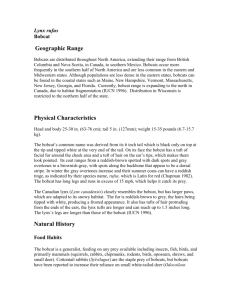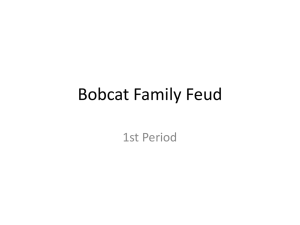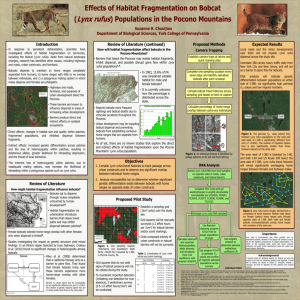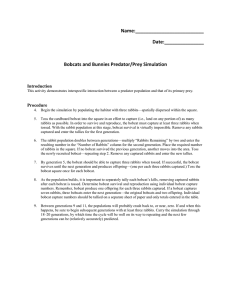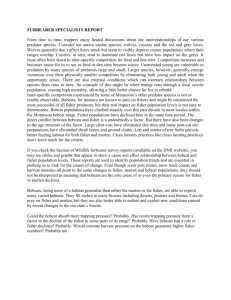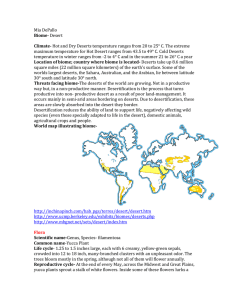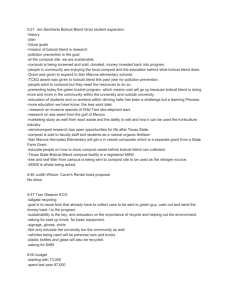MAMMALS OF MISSISSIPPI 13:1-5 Bobcat BEN N. WALKER, IV
advertisement
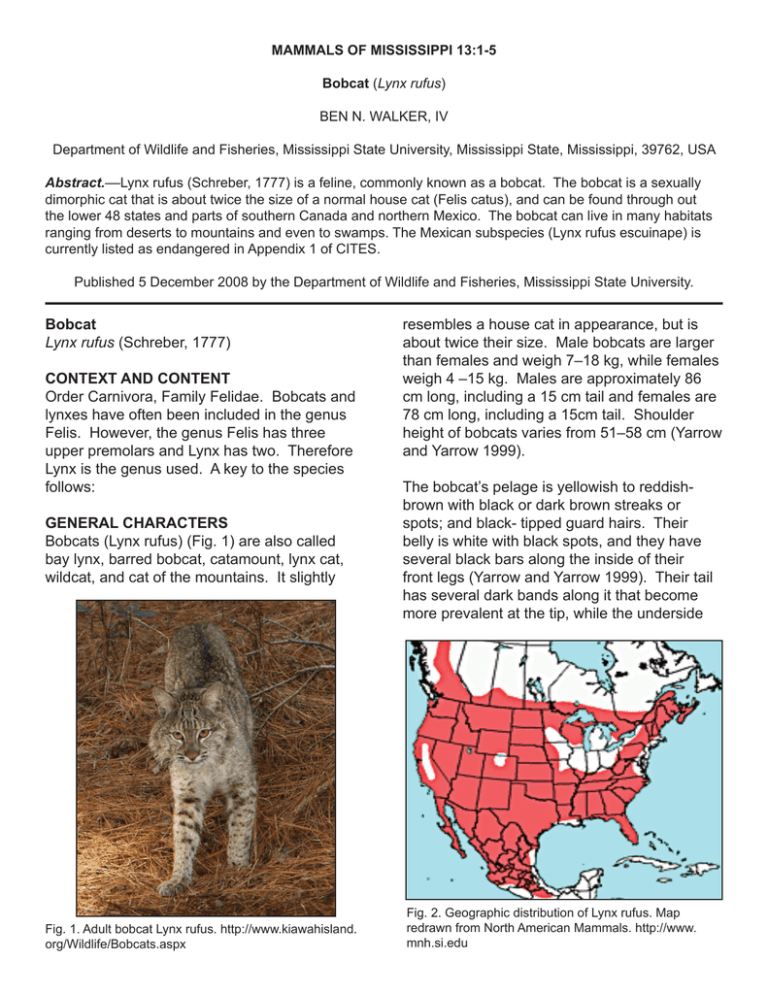
MAMMALS OF MISSISSIPPI 13:1-5 Bobcat (Lynx rufus) BEN N. WALKER, IV Department of Wildlife and Fisheries, Mississippi State University, Mississippi State, Mississippi, 39762, USA Abstract.––Lynx rufus (Schreber, 1777) is a feline, commonly known as a bobcat. The bobcat is a sexually dimorphic cat that is about twice the size of a normal house cat (Felis catus), and can be found through out the lower 48 states and parts of southern Canada and northern Mexico. The bobcat can live in many habitats ranging from deserts to mountains and even to swamps. The Mexican subspecies (Lynx rufus escuinape) is currently listed as endangered in Appendix 1 of CITES. Published 5 December 2008 by the Department of Wildlife and Fisheries, Mississippi State University. Bobcat Lynx rufus (Schreber, 1777) CONTEXT AND CONTENT Order Carnivora, Family Felidae. Bobcats and lynxes have often been included in the genus Felis. However, the genus Felis has three upper premolars and Lynx has two. Therefore Lynx is the genus used. A key to the species follows: GENERAL CHARACTERS Bobcats (Lynx rufus) (Fig. 1) are also called bay lynx, barred bobcat, catamount, lynx cat, wildcat, and cat of the mountains. It slightly Fig. 1. Adult bobcat Lynx rufus. http://www.kiawahisland. org/Wildlife/Bobcats.aspx resembles a house cat in appearance, but is about twice their size. Male bobcats are larger than females and weigh 7–18 kg, while females weigh 4 –15 kg. Males are approximately 86 cm long, including a 15 cm tail and females are 78 cm long, including a 15cm tail. Shoulder height of bobcats varies from 51–58 cm (Yarrow and Yarrow 1999). The bobcat’s pelage is yellowish to reddishbrown with black or dark brown streaks or spots; and black- tipped guard hairs. Their belly is white with black spots, and they have several black bars along the inside of their front legs (Yarrow and Yarrow 1999). Their tail has several dark bands along it that become more prevalent at the tip, while the underside Fig. 2. Geographic distribution of Lynx rufus. Map redrawn from North American Mammals. http://www. mnh.si.edu them kill large prey (Kelson 1946). Their sagittal crest is well developed providing jaw strength, and the mandible is almost straight giving them a prominent chin (Larivière and Walton 1997). Fig. 3.––Distribution of Mustela frenata in North America. is white. The bobcat’s fur is dense, short, and very soft; and it has no true color phase. There is considerable coat variation between individual bobcats (Fritts and Sealander 1978). Bobcats have a short, broad face with ruffs of fur on each side. Their ears are prominent and pointed with a tuft of black hair on the tip. The hair on the back of the ear is black with a central white spot (Fritts and Sealander 1978). Bobcats also have sharp retractable claws. They have four toes on their hind feet and five toes on their front feet. However, their tracks only show four toes on the front feet because the fifth toe is raised (Fritts and Sealander 1978). DISTRIBUTION Bobcats have historically ranged throughout the lower 48 states, (Fig. 2) as well as parts of southern Canada and northern Mexico (Yarrow and Yarrow 1999). Currently the bobcat is located in southern Canada and the United States, except in Alaska, Hawaii, Vancouver Island, Prince Edward Island, and Newfoundland. The bobcat population has been drastically reduced in the Ohio Valley, upper Mississippi Valley, and southern Great Lakes area (Larivière and Walton 1997). FORM AND FUNCTIONS The male bobcat skull (Fig. 3) is on average 3% larger in linear measurements than the female bobcat skull (Hall and Kelson 1959). Their lambdoidal ridge is well developed which strengthens their cervical musculature, helping The bobcat’s dentition is highly specialized for killing prey and shearing meat. Adult bobcat carnassials provide greater shear force due to the proximity to the jaw angle. Their dental formula is i 3/3, c 1/1, p 2/2, m 1/1 total 28 (Larivière and Walton 1997). The clitoris in the female bobcat is minute; the glans penis of the male bobcat is short, subconical, and usually armed with a backwardly directed spiny papilla (Larivière and Walton 1997). The adrenal glands in the males are heavier than they are in the females, and their size is correlated with reproductive status. Bobcats have four mammae, two abdominal, and two inguinal (Larivière and Walton 1997). The bobcat is a digitigrade with sharp retractile claws. The front feet are larger than hind feet, which have four toes that are connected by a web (McCord and Cardoza 1982). The bobcat’s food intake varies with physical condition. Energy consumption averages 138 kcal kg-1 day-1, and intake energy is allocated as follows: feces 9%, urine 8%, weight gain 6%, and metabolism 77% (Larivière and Walton 1997). The amount of metabolized energy varies among prey types, with white-tailed deer having the highest energy level. The bobcat’s standard metabolic rate is 79 kcal/kg of body weight and does not vary seasonally (Mautz and Pekins 1989). ONTOGENY AND REPRODUCTION Female bobcats usually come into heat once a year from January through March (Fritts and Sealander 1978). If the female fails to become pregnant, she may come back into heat again later in the spring. Female bobcats are induced ovulators and may experience an estrus in the first year of their life; however, most breed in their second spring (Larivière and Walton 1997). Their gestation period averages about 62 days. Their litter consists of one to four kittens (usually three), which are born in a crude nest inside their den (Fritts and Sealander 1978). Although most births occur from April through June, kittens may be born during any month of the year (Larivière and Walton 1997). The kittens open their eyes in 10 days and begin eating solid food by the end of their fourth week (Yarrow and Yarrow 1999). Deciduous dentition erupts between 11-14 days of age and is completed by the time the kittens are 9 weeks old. The kittens have their permanent teeth erupt between 16-19 weeks of age, and they have their complete adult dentition by 34 weeks of age (Larivière and Walton 1997). They are weaned by the seventh or eighth week, but remain with the mother until autumn (Fritts and Sealander 1978). ECOLOGY Bobcat densities are normally low; typical densities average about one animal per 5 to 8 km2 (Yarrow and Yarrow 1999). Most of the bobcat’s mortality occurs in the juvenile class. Forty to 50% of all bobcat juveniles do not live to two years of age. The leading factor for this early death rate is food availability (Fuller et al. 1995). Young bobcats are most susceptible to death once they leave their mothers and begin establishing their home range. While mature bobcats are not normally preyed on, kittens may be preyed upon by foxes, owls, and adult male bobcats (Yarrow and Yarrow 1999). The bobcat is adapted to a wide variety of habitat types, from deserts to mountains and even to swamps. The only type of habitat that they cannot utilize is farmed agricultural land where swamps and forested areas have been eliminated (Yarrow and Yarrow 1999). Key habitat components include prey abundance, protection from weather, rest areas, dense cover, and denning sites. Bobcats use hollow logs and trees, old beaver dams, and brush piles for denning and resting sites (Lovallo et al. 1993). Bobcats may have several dens located throughout their territory. These auxiliary dens are located in areas of the territory that are not as often visited, and usually consist of brush piles, stumps, or logs for shelter from the weather (Lovallo et al. 1993). The size of their home range varies according to prey availability and abundance, sex, season, climate, and topography (Plowman et al. 2006). Bobcat home ranges tend to be large, which accounts for the low densities throughout much of their range. Ranges vary from 2 to 129 km2. Male home ranges are usually two to five times larger than those of females. Male home ranges also tend to overlap several female home ranges; whereas female home ranges do not tend to overlap other female home ranges (Chamberlain et al. 2003). Bobcats are opportunistic carnivores. Mammalian prey is most prevalent in their diet, but they will also eat insects, fish, reptiles, amphibians, and birds (Yarrow and Yarrow 1999). They are most adapted to preying on rabbits (Sylvilagus spp.); however they can kill animals weighing up to 5 kilograms. The diets of bobcats in Mississippi include Virginia opossum (Didelphis virginiana), squirrels (Sciurus spp.), rats, mice, shrews, American beaver (Castor Canadensis), eastern wild turkey (Meleagris gallopava silvestris), and adult and fawn white-tailed deer (Odocoileus virginianus; Chamberlain and Leopold 1999). Due to the solitary nature of bobcats and their constant changing of den and resting sites, they rarely succumb to die-offs from disease or heavy parasitic infections (Yarrow and Yarrow 1999). BEHAVIOR Bobcats are territorial, and often confine their movements and activities to specific home ranges. Transient cats, which are young or sexually immature, may exhibit long range, erratic movement, but eventually settle into home ranges that are vacant due to death or removal of the resident bobcat (Larivière and Walton 1997). Their territorial boundaries are often marked using their feces (scat), their urine, their anal glands, and their feet scrapings. In addition, they also use stretching trees, which are dry snags without any bark, to mark their territory (Yarrow and Yarrow1999). Bobcats use a polygynous mating system, and uniparental care is exhibited by the females (Chamberlain et al. 2003). Courtship behavior includes pursuit, running encounters, bumping and ambushes. They may copulate two to five times in a relatively short period of time. A neck grip might be necessary before the male can mount the female and rape attempts might occur (Larivière and Walton 1997). LITERATURE CITED Chamberlain, M. J., B. D. Leopold, and L. M. Conner. 2003. Space Use, Movements and Habitat Selection of Adult Bobcats (Lynx rufus) in Central Mississippi. The American Midland Naturalist, 149: 395405. Chamberlain, M. J., and B. D. Leopold. 1999. Dietary Patterns of Sympatric Bobcats and Coyotes in Central Mississippi. Southeastern Association of Fish and Wildlife Agencies, 53: 204-219. Fritts, S. H., and J. A. Sealander. 1978a. Reproductive Biology and Population Characteristics of Bobcats (Lynx rufus) Arkansas. Journal of Mammalogy, 59: 347-353. Fuller, T. K., S. L. Berendzen, T. A. Decker, and J. E. Cardoza. 1995. Survival and Cause Specific Mortality Rates of Adult Bobcats (Lynx rufus). The American Midland Naturalist, 134: 404-408. Hall, E. R., and K. R. Kelson. 1959. The Kelson, K. R. 1946. Notes on the Comparative Osteology of the Bobcat and the House Cat. Journal of Mammalogy, 27:255-264. Larivière, S., and L. R. Walton. 1997. Lynx rufus. Mammalian Species, 563: 1-8. Bobcat vocalizations include caterwauling, spits, growls, puffs, and hisses when threatened (Larivière and Walton 1997). Bobcats are great swimmers, and may enter water for fishing, defecating, or playing. They are mostly nocturnal, and both sexes exhibit a similar bimodal pattern of activity (Larivière and Walton 1997). GENETICS The bobcat has 38 chromosomes, with 32 metacentrics, submetacentrics, or subtelocentrics and four acrocentrics. Both sex chromosomes are submetacentric (Larivière and Walton 1997). Lovallo, M. J., J. H. Gilbert, and T.M. Gehring. 1993. Bobcat, Felis rufus, Dens in abandoned beaver, Castor canadensis, lodge. The Canadian Field Naturalist, 107: 108-109. Mautz, W. W., and P. J. Perkins. 1989. Metabolic Rate of Bobcats as Influenced by Seasonal Temperatures. The Journal of Wildlife Management, 53:202-205. McCord, C. M., and J. E. Cardoza. 1982. Bobcat and Lynx. In Wild Mammals of North America: biology management and economics (J. A. Chapman and G. A. Feldhamer, eds.). The John Hopkins University Press, Baltimore, Maryland, 1147 pp. Plowman, B. W., L. M. Conner, M. J. Chamberlain, B.D. Leopold, L.W. Burger JR. 2006. Annual Dynamics of Bobcat (Lynx rufus) Home Range and Core Use Areas of Mississippi. The American Midland Naturalist, 156: 386-393. Schreber, J. C. D. [1776] 1777. Die Saugethiere in Abbildungen nach der Natur, mit Beschreibungen. Wolfgang Walther, Erlangen, 1112 pp. Yarrow, G.K., and D.T. Yarrow. 1999. Managing Wildlife. Sweet Water Press, Birmingham, AL, 1:248-249. Contributing editor of this account was Clinton Smith.
